
3 tips to entice the TikTok generation to work in manufacturing
Advanced technology has changed manufacturing forever. And while digital transformation might still be a scary concept for some in the industry, the manufacturing floor post-digitalization looks a lot more enticing for a new generation of innovators.
According to Citrix, by 2035, many organizations will be run by Digital Natives: millennials and Gen Z’s that have grown up either adapting alongside the technological boom or being born in the midst of it. The Born Digital Effect looks at the impact that younger workers of today – the C-Suite of 2035 – are having on the organizations they work for, and what leaders can do to attract and retain them in their business.
So, how do we entice the so-called TikTok generation to work in manufacturing? It might be easier than you think. The manufacturing industry is uniquely positioned in today’s competitive job market – with the emergence of smart manufacturing opening exciting new doors for the next wave of innovative thinkers to work with advanced technology in the workplace.
Let’s explore three simple tips to attract and retain this next generation of manufacturers.
1. Embrace technology

There’s really no excuse not to! Smartphones, smart watches, Internet of Things (IoT) sensor technology, and digital manufacturing platforms improve productivity and are more affordable than ever before. Bringing this advanced technology into one software as a service (SaaS) solution was previously only available to enterprise organizations with the budget to implement the already costly solutions on a large scale. But now, innovative digital platforms such as TilliT are being designed to cater specifically for SMEs to digitalize and begin their smart manufacturing journey, whether that’s on one line or the whole factory.
Embracing technology on the shop floor can improve operational efficiencies while enticing digital natives to a technology-oriented workforce. Imagine, you’re a digital native, about to embark on a manufacturing career. Even at the surface level – which workplace would you choose?
-
A paper-based manufacturing plant with spreadsheets, pens, and paper across the factory floor, or,
-
A smart manufacturing plant harnessing tablets, smartphones, IoT technology, and digital platforms.
Let’s think about that for a minute. Most digital natives have used tablets since grade school, or sooner! Imagine crossing paths with a paper spreadsheet after a lifetime of digital exposure – it would be like jumping into a time machine every time you head to work. Unfortunately, this is a harsh truth that we see all too often. Many factories are still paper-based; stuck in traditional methods, wary of change, or unaware there are affordable options on the market.
Smart manufacturing offers a much closer reflection to our day-to-day technology habits and builds a Gen Z-friendly work environment. Embracing technology allows us to gain insights from data analysis or artificial intelligence (AI) to unlock more efficient ways of working, making our own working lives simpler in the process.
2. Upskill your workforce

We’ve talked about embracing technology as being a great way to entice the next generation of digital-native workers. But that’s only half the battle. Honestly, you might as well disregard our first tip if the second is ignored. Upskilling your workforce to effectively use the technology you’re implementing on your smart manufacturing journey is just as crucial as embracing it in the first place.
Upskilling should involve everyone that will be using the technology. This might be achieved by utilizing a company such as Skills Lab to upskill your workforce using your unique technology. With some technology platforms, training packages can be added on. At TilliT for example, we’ll guide you and your operating team through the platform and provide training during this process – while also making sure you’re equipped to onboard new staff to remain self-sufficient.
Serving the connected worker (any worker adapting to new digital and other technologies) prepares your manufacturing plant for what’s next, and encourages young jobseekers to join your organization so that they can learn new skills and grow their career.
According to LinkedIn’s 2022 Workplace Learning Report, employees’ top three motivations to learn hinge on career development:
-
If it helps me stay up to date in my field,
-
If it is personalized specifically for my interest and career goals,
-
If it helps me get another job internally, be promoted, or get closer to reaching my career goals.
Plus, let’s not forget about those already in these jobs! Upskilling your workforce ensures current employees can adapt and thrive in a smart manufacturing environment while assisting the transition using their extensive knowledge of existing systems. Capturing the knowledge passed on from experienced workers is just as important as integrating the next generation. Digitalizing requires buy-in from everyone, so ensuring there are opportunities for both new and existing workers is critical.
3. Foster career pathways

Introducing enhanced visibility across the shop floor can introduce a way of working that provides real-time feedback up the chain. With a digital software system, both staff and management have better visibility into performance metrics, providing more opportunities to incentivize work that adds value to the business while offering more clearly defined career pathways for employees.
In smart manufacturing, there are more opportunities to see how individual performance impacts the wider business, allowing management to gain a better overall picture of operations. With a greater understanding of efficiencies, you can gain insights into where workers are best suited to doing their best work. With data like this at your fingertips, it’s easier to set professional development goals and build clear career pathways in manufacturing. Not only can you better reward excellent work via promotion or bonus incentives, but you can also ensure workers are playing to their strengths.
LinkedIn’s 2022 Workplace Learning Report revealed that employees who feel their skills aren’t being utilized at work are 10 times more likely to be looking for a new job than those who feel that their skills are. Smart manufacturing affords the visibility to shuffle workers into their preferred roles, balanced with insights into their greatest strengths.
In TilliT, for example, operators and managers can see all aspects of the shop floor in an easy-to-use dashboard. For operators, TilliT’s digital workflow provides prompts to perform tasks in day-to-day operations, making onboarding new employees easier and allowing them to focus on using their hands-on skills on the shop floor. For managers, enhanced visibility across tasks can not only ensure operations are running smoothly, but provides insights into people, processes, and equipment to utilize employee skills and company resources more effectively.
Get started with smart manufacturing
There’s a common theme across these three easy tips – they all revolve around nurturing a smart manufacturing environment. The benefits of embracing technology, upskilling, and fostering career pathways in manufacturing are made a whole lot easier with the capabilities afforded by digitalization.
Digital natives don’t want to use paper or do tedious tasks in a vintage, cluttered, or hazardous manufacturing plant. Enticing the TikTok generation with a workplace that interweaves advanced technology to better reflect Gen Z technology habits, positions smart manufacturing as an exciting and attractive industry for new generations entering the workforce.
Learn more about how you can get started with smart manufacturing, by downloading our free eBook.
Enjoyed this post? Don't forget to share!



